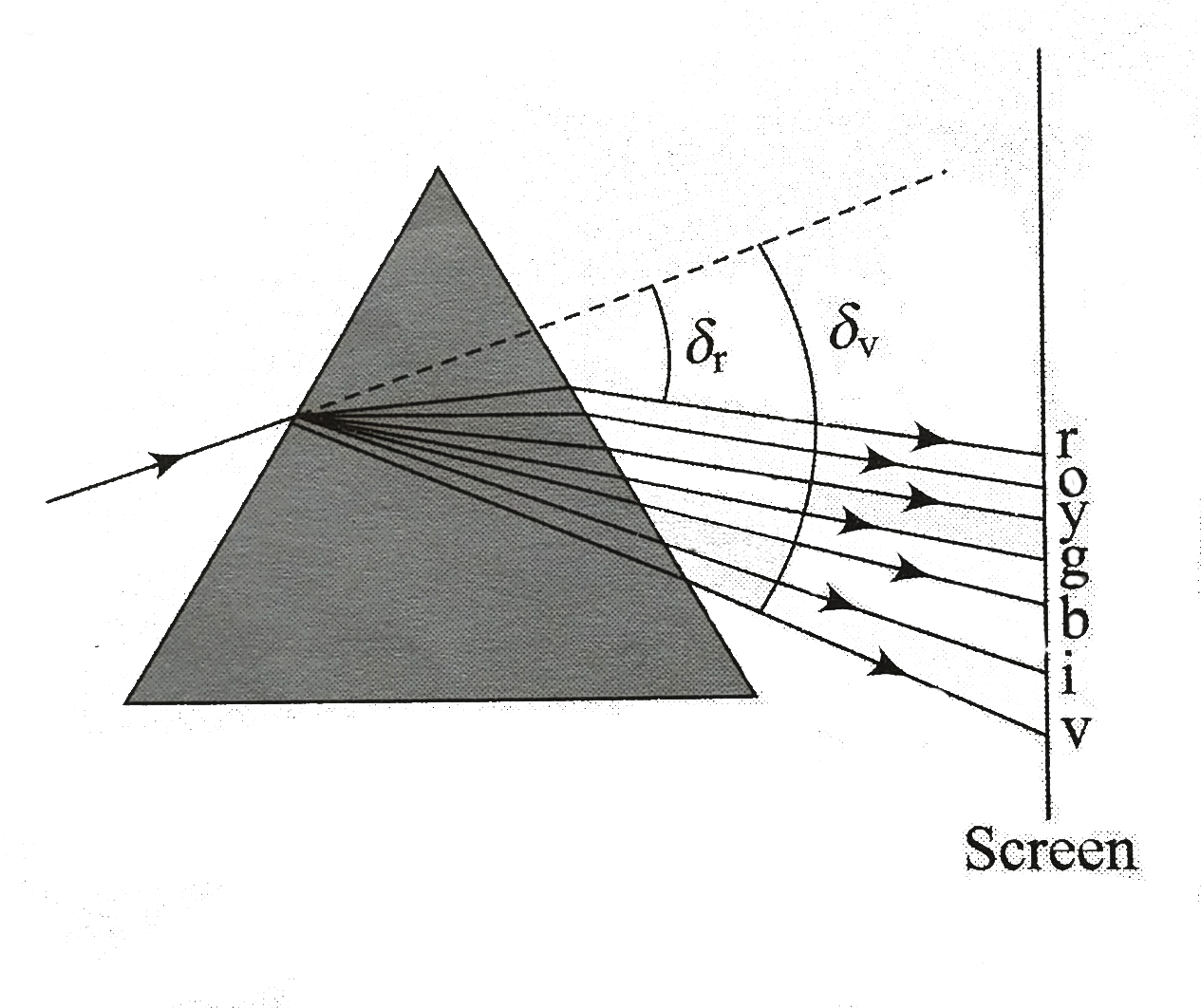Find the angle of a prism of dispersive power 0.020 and refractive index 1.60 to form an achromatic combination with the prism of angle 4∘ and dispersive power 0.040 having refractive index 1.75. Also calculate the resultant deviation.
To solve the problem, we need to find the angle of a prism with a dispersive power of 0.020 and a refractive index of 1.60 that will form an achromatic combination with another prism that has an angle of 4 degrees, a dispersive power of 0.040, and a refractive index of 1.75. We will also calculate the resultant deviation.
1. Understanding the Condition for Achromatic Combination:
The condition for two prisms to form an achromatic combination is given by:
ω1(μ1−1)A1+ω2(μ2−1)A2=0
where:
- ω1 and ω2 are the dispersive powers of the prisms,
- μ1 and μ2 are the refractive indices,
- A1 and A2 are the angles of the prisms.
2. Substituting Known Values:
For the first prism:
- ω1=0.020
- μ1=1.60
- A1=? (this is what we need to find)
For the second prism:
- ω2=0.040
- μ2=1.75
- A2=4∘
Plugging these values into the equation gives:
0.020(1.60−1)A1+0.040(1.75−1)(4∘)=0
3. Calculating the Terms:
- μ1−1=1.60−1=0.60
- μ2−1=1.75−1=0.75
Now substituting these values:
0.020×0.60A1+0.040×0.75×4∘=0
4. Simplifying the Equation:
- Calculate 0.040×0.75×4:
0.040×0.75=0.030and0.030×4=0.12
So the equation becomes:
0.012A1+0.12=0
5. Solving for A1:
Rearranging gives:
0.012A1=−0.12
A1=−0.120.012=−10∘
6. Calculating the Resultant Deviation:
The resultant deviation D for the two prisms can be calculated using:
D=(μ1−1)A1+(μ2−1)A2
Substituting the values:
D=(1.60−1)(−10∘)+(1.75−1)(4∘)
D=(0.60)(−10)+(0.75)(4)
D=−6+3=−3∘
Final Answers:
- The angle of the first prism A1=10∘.
- The resultant deviation D=−3∘.
The condition for two prisms to form an achromatic combination is given by:
ω1(μ1−1)A1+ω2(μ2−1)A2=0
where:
- ω1 and ω2 are the dispersive powers of the prisms,
- μ1 and μ2 are the refractive indices,
- A1 and A2 are the angles of the prisms.
For the first prism:
- ω1=0.020
- μ1=1.60
- A1=? (this is what we need to find)
- ω2=0.040
- μ2=1.75
- A2=4∘
0.020(1.60−1)A1+0.040(1.75−1)(4∘)=0
- μ1−1=1.60−1=0.60
- μ2−1=1.75−1=0.75
0.020×0.60A1+0.040×0.75×4∘=0
- Calculate 0.040×0.75×4:
0.040×0.75=0.030and0.030×4=0.12
So the equation becomes:
0.012A1+0.12=0
Rearranging gives:
0.012A1=−0.12
A1=−0.120.012=−10∘
The resultant deviation D for the two prisms can be calculated using:
D=(μ1−1)A1+(μ2−1)A2
Substituting the values:
D=(1.60−1)(−10∘)+(1.75−1)(4∘)
D=(0.60)(−10)+(0.75)(4)
D=−6+3=−3∘
- The angle of the first prism A1=10∘.
- The resultant deviation D=−3∘.
Topper's Solved these Questions
- RAY OPTICS BOOK - VMC MODULES ENGLISHCHAPTER - RAY OPTICS EXERCISE - Example
21 Videos
- RAY OPTICS BOOK - VMC MODULES ENGLISHCHAPTER - RAY OPTICS EXERCISE - PRACTICE EXERCISE-1
1 Video
- QUIZBOOK - VMC MODULES ENGLISHCHAPTER - QUIZEXERCISE - PHYSICS
30 Videos
- RAY OPTICS AND WAVE OPTICS BOOK - VMC MODULES ENGLISHCHAPTER - RAY OPTICS AND WAVE OPTICS EXERCISE - IMPECCABLE
58 Videos
Similar Questions
A prism of refracting angle 4∘ is made of a material of refractive index 1.652. Find its angle of minimum deviation.
View SolutionFor a prism of refractive index 1.732, the angle of minimum deviation is equal to the angle of the prism. The angle of the prism is
View SolutionIn a certain spectrum produced by a glass prism of dispersive power 0.0305, it is found that the refractive index for the red ray is 1.645.and that for the violet ray is 1.665. What is the refractive index for the yellow ray?
View SolutionIf the angle of minimum deviation is of 60∘ for an equilateral prism , then the refractive index of the material of the prism is
View SolutionThe refracting angle of a prism is A, and refractive index of the material of the prism is cot(A2). The angle of minimum deviation is
View SolutionFind the angle of deviation suffered by the light ray shown in figure. The refractive index μ=2.0 for the prism material.
View SolutionA thin prism of angle A=6∘ produces a deviation d=3∘. Find the refractive index of the material of prism.


View SolutionAn equilateral glass prism is made of a material of refractive index 1.500. Find its angle of minimum deviation.
View SolutionA thin prism having refracting angle 10∘ is made of glass of refracting index 1.42. This prism is combined with another thin prism of glass of refractive index 1.7. This combination produces dispersion without deviation. The refracting angle of second prism should be :
View SolutionThe refractive index of a prism is 2. this prism can have a maximum refracting angle of
View Solution
